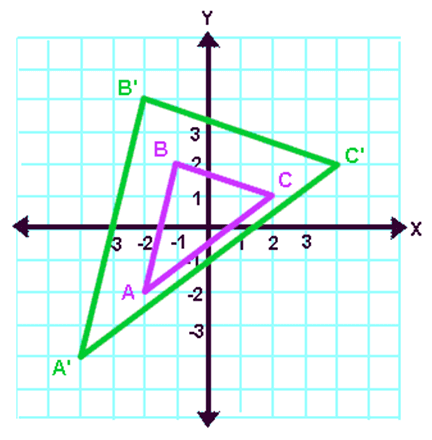DILATION TRANSFORMATION IN GEOMETRY
Subscribe to our ▶️ YouTube channel 🔴 for the latest videos, updates, and tips.
Dilation transformation is one of the four types of transformations in geometry.
Dilation - Definition
A dilation is a transformation that produces an image that is the same shape as the original, but is a different size. NOT an isometry. Forms similar figures.
In simple words, dilation means, it just re sizes the given figure without rotating or anything else.
Dilation Rule
Dilation of scale factor k :
(x, y) ----> (kx, ky)
Dilation for k = 2

Once students understand the above mentioned rule which they have to apply for dilation transformation, they can easily make dilation-transformation of a figure.
For example, if we are going to make dilation transformation of the point (5, 3) for the scale factor k = 2, after transformation, the point would be (10, 6).
Here, the rule we have applied is
(x, y) ----> (kx, ky)
For k = 2, we get
(5, 3) ----> (10, 6)
Let us consider the following example to have better understanding of translation.
Question :
Let A(-2, -2), B(-1, 2) and C(2, 1) be the three vertices of a triangle. If this triangle is dilated for the scale factor "k = 2 ", what will be the new vertices A', B' and C'?
Solution :
Step 1 :
First we have to know the correct rule that we have to apply in this problem.
Step 2 :
Here, triangle is dilated for the scale factor k = 2.
So, the rule that we have to apply here is
(x, y) ----> (kx , ky)
Step 3 :
Based on the rule given in step 1, we have to find the vertices of the dilated triangle A'B'C'.
Step 4 :
(x, y) ----> (kx, ky)
A(-2, -2) ----> A'(-4, -4)
B(-1, 2) ----> B'(-2, 4)
C(2, 1) ----> C'(4, 2)
Step 5 :
Vertices of the dilated triangle are
A'(-4, -4), B(-2, 4) and C'(4, 2)
How to sketch the dilated figure?
1. First we have to plot the vertices of the pre-image.
2. In the above problem, the vertices of the pre-image are
A(-2, -2), B(-1, 2) and C(2, 1)
3. When we plot these points on a graph paper, we will get the figure of the pre-image (original figure).
4. When we dilate the given figure for k = 2, we have to apply the formula
(x, y) ----> (kx, ky)
5. When we apply the formula, we will get the following vertices of the image (dilated figure).
6. In the above problem, vertices of the image are
A'(-4, -4), B'(-2, 4) and C'(4, 2)
7. When plot these points on the graph paper, we will get the figure of the image (dilated figure).
Subscribe to our ▶️ YouTube channel 🔴 for the latest videos, updates, and tips.
Kindly mail your feedback to v4formath@gmail.com
We always appreciate your feedback.
About Us | Contact Us | Privacy Policy
©All rights reserved. onlinemath4all.com

Recent Articles
-
10 Hard SAT Math Questions (Part - 40)
Dec 25, 25 08:30 AM
10 Hard SAT Math Questions (Part - 40) -
10 Hard SAT Math Questions (Part - 41)
Dec 24, 25 07:58 PM
10 Hard SAT Math Questions (Part - 41) -
ASTC Formula in Trigonometry
Dec 23, 25 11:34 PM
ASTC Formula in Trigonometry - Concepts - Examples and Solved Problems


